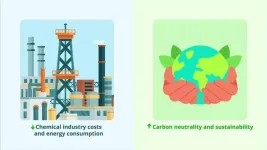(Press-News.org) How much fuel can we add to the fire while still maintaining control?
Metaphorically speaking, that’s the question one team at the U.S. Department of Energy’s Princeton Plasma Physics Laboratory (PPPL) has been asking themselves lately.
Now, they believe they have the answer for one particular scenario. It’s all a part of the Lab’s work to bring energy from fusion to the power grid.
Building upon recent findings showing the promise of coating the inner surface of the vessel containing a fusion plasma in liquid lithium, the researchers have determined the maximum density of uncharged, or neutral, particles at the edge of a plasma before the edge of the plasma cools off and certain instabilities become unpredictable. Knowing the maximum density for neutral particles at the edge of a fusion plasma is important because it gives the researchers a sense of how and how much to fuel the fusion reaction.
The research, which is featured in a new paper in Nuclear Fusion, includes observations, numerical simulations and analysis from their experiments inside a fusion plasma vessel called the Lithium Tokamak Experiment-Beta (LTX-β).
The unique environment of LTX-β
LTX-β is one of many fusion vessels around the world that holds plasma in a donut shape using magnetic fields. Such vessels are known as tokamaks. What makes this tokamak special is that its inner walls can be coated, almost completely, in lithium. This fundamentally changes the wall behavior, as the lithium holds on to a very high percentage of the hydrogen atoms coming off the plasma. Without the lithium, far more hydrogen would bounce off the walls and back into the plasma. In early 2024, the research team reported that this low recycling environment for hydrogen keeps the very edge of the plasma hot, making the plasma more stable and providing room for a larger volume of plasma.
“We are trying to show that a lithium wall can enable a smaller fusion reactor, which will translate into a higher power density,” said Richard Majeski, a managing principal research physicist at PPPL and head of LTX-β. Ultimately, this research could translate into the cost-effective fusion power source the world needs.
Now, the LTX-β team has published additional findings showing the relationship between the fuel for the plasma and its stability. Specifically, the researchers found the maximum density of neutral particles at the edge of a plasma inside LTX-β before the edge starts to cool, potentially leading to stability problems. The researchers believe they can reduce the likelihood of certain instabilities by keeping the density at the edge of the plasma below their newly defined level of 1 x 1019 m–3. This is the first time such a level has been established for LTX-β, and knowing it is a big step in their mission to prove lithium is the ideal choice for an inner-wall coating in a tokamak because it guides them toward the best practices for fueling their plasmas.
In LTX-β, the fusion is fueled in two ways: using puffs of hydrogen gas from the edge and a beam of neutral particles. Researchers are refining how to use both methods in tandem to create an optimal plasma that will sustain fusion for a long time in future fusion reactors while generating enough energy to make it practical for the power grid.
Refining methods for retaining an even temperature across the plasma
Physicists often compare the temperature at its edge to its core temperature to assess how easy it will be to manage. They plot these numbers on a graph and consider the slope of the line. If the temperature at the inner core and outer edge are nearly the same, the line is almost flat, so they call that a flat temperature profile. If the temperature at the outer edge is significantly lower than the temperature at the inner core, scientists call it a peaked temperature profile.
“The team determined the maximum density of neutral particles beyond the edge of a plasma that still allows for a flat-edge temperature profile. Going beyond that number of neutrals at the edge definitely will drop your edge temperature, and you will end up in a peaked temperature profile,” said Santanu Banerjee, a staff research physicist at PPPL and lead author on the new paper.
“That same neutral density is the threshold for instabilities known as tearing modes. Beyond that density, tearing modes tend to get destabilized, cause threats to the plasma and may stop the fusion reaction if left uncontrolled.”
If the instabilities become too large, the fusion reaction will end. In order to support the power grid, researchers are figuring out the best ways to manage a fusion plasma so that the reaction is stable.
Banerjee and Majeski worked with several other researchers on the paper, including PPPL’s Dennis Boyle, Anurag Maan, Nate Ferraro, George Wilkie, Mario Podesta and Ron Bell.
Work on the project continues. PPPL engineer Dylan Corl is optimizing the direction in which the neutral beam, which is used to heat the plasma, is injected into the tokamak. “We’re basically creating a new port for it,” Corl said. He uses a 3D model of the LTX-β, testing different beam trajectories to ensure the beam won’t hit another part of the equipment, such as tools used to measure the plasma. “Finding the best angle has been a challenge, but I believe we’ve got it now,” Corl said.
The U.S. Department of Energy funded this research under award numbers DE-AC02-09CH11466, DE-SC0019006, DE-AC0500OR22725 and DE-SC0019239.
END
Adding just enough fuel to the fire
A PPPL research team tests the limits of fusion plasma inside a reactor coated in liquid lithium as a part of their quest toward cost-effective power
2024-03-28
ELSE PRESS RELEASES FROM THIS DATE:
Impact of synbiotic supplements on the gut microbiome and overall health of penguins
2024-03-28
A healthy gut plays an indispensable role in the absorption and metabolism of nutrients, maintaining immune function, and promoting general well-being. The profound impact of a healthy microbiome is not just limited to the gut, but there is mounting evidence that it influences almost every function of the body. Thus, the composition of the gut microbiome becomes an important indicator of health status of the body.
Probiotics are a type of supplements containing live strains of bacteria that improve and diversify the gut microbiome population. Lactiplantibacillus plantarum, a type of microorganism ...
Promising advances in organosilica membranes for separating organic liquid mixtures
2024-03-28
In many chemical-related industries, such as pharmaceuticals, oil refineries, and food and beverage factories, separating organic liquid mixtures is an essential step. A staple method to achieve this is distillation, which involves heating a mixture to a specific temperature so that only one of its components vaporizes. Though widely used, distillation fails to separate organic liquid mixtures in which both components have the same boiling point. Moreover, it’s an energy- and resource-intensive process, ...
Cell phone video technology unveils new method for analyzing walking and gait
2024-03-28
BALTIMORE, March 27, 2024— Researchers at Kennedy Krieger Institute and Johns Hopkins Medicine have developed a new, accessible approach to analyze a patient’s walking ability and stances more effectively. Following numerous tests, they determined that a simple video recorded on a personal pocket device, such as a smartphone or tablet, can be used to measure gait at a clinical, high-quality level.
Experts say current state-of-the-art approaches to gait analysis are often expensive and inaccessible due ...
Ancient isolation’s impact on modern ecology
2024-03-28
A new study led by Michigan State University researcher Peter Williams sheds light on the profound influence of deep geographic isolation on the evolution of mammals. Published in Nature Communications on March 28, the research reveals how long-lasting separation between continents has shaped distinct mammal communities around the globe.
“Today’s ecology was not inevitable. If there were different isolating factors long ago, we might have vastly different ecosystems today,” said Peter Williams, the lead author of the study. Williams is a research ...
Synaptic protein change during development offers clues on evolution and disease
2024-03-28
The first analysis of how synaptic proteins change during early development reveals differences between mice and marmosets but also what's different in individuals with autism spectrum disorders. The Kobe University findings offer first insights into the mechanism behind synaptic development and open up routes for research on possible treatments.
Given that synapses are the connections between our brain cells, one might think that having as many of these as possible is a good thing. However, primate brains do something unexpected: After early childhood, ...
How commercial rooftop solar power could bring affordable clean energy to low-income homes
2024-03-28
Lower-income communities across the United States have long been much slower to adopt solar power than their affluent neighbors, even when local and federal agencies offer tax breaks and other financial incentives.
But, commercial and industrial rooftops, such as those atop retail buildings and factories, offer a big opportunity to reduce what researchers call the “solar equity gap,” according to a new study, published in Nature Energy and led by researchers at Stanford University.
“The ...
Taking a closer look at pulmonary fibrosis genetics
2024-03-28
PHOENIX, Ariz. — March 28, 2024 — Regulators of gene expression are thought to play an outsized role in disorders from cancers to heart disease. But how exactly do variations in gene regulation translate into a disease’s biology?
A team of scientists led by researchers from the Translational Genomics Research Institute (TGen), part of the City of Hope, together with investigators at St. Vincent’s Institute of Medical Research and Vanderbilt University Medical Center, now have a better answer for this question when it comes to pulmonary fibrosis (PF), an incurable respiratory disease.
Their study, published today in Nature Genetics, is the first to look at these ...
Cats with MDR1 mutation at risk of severe reactions to popular medication
2024-03-28
PULLMAN, WA -- More than half a million cats in the United States could be at risk of a severe or even fatal neurological reaction to the active ingredient in some top-selling parasite preventatives for felines.
While the ingredient, eprinomectin, which is found in products like NexGard COMBO and Centragard, appears safe and effective for the significant majority of cats when used at label doses, a study conducted by Washington State University’s Program for Individualized Medicine identified a risk of severe adverse effects in cats with the ...
IOP Publishing and IPEM mandate reporting of sex and gender in research
2024-03-28
IOP Publishing (IOPP) and the Institute of Physics and Engineering (IPEM) have introduced checks for sex and gender equality for all manuscripts submitted to their jointly published journal Physiological Measurement.
In line with the Sex and Gender Equity in Research (SAGER) guidelines, which were introduced to ensure that sex and gender considerations are appropriately reported in scholarly literature, all research published in Physiological Measurement must declare the sex and gender balance of subject groups. Authors are ...
Dogs trained to detect trauma stress by smelling humans’ breath
2024-03-28
Dogs’ sensitive noses can detect the early warning signs of many potentially dangerous medical situations, like an impending seizure or sudden hypoglycemia. Now, scientists have found evidence that assistance dogs might even be able to sniff out an oncoming PTSD flashback, by teaching two dogs to alert to the breath of people who have been reminded of traumas.
“PTSD service dogs are already trained to assist people during episodes of distress,” said Laura Kiiroja of Dalhousie University, first author of the paper ...
LAST 30 PRESS RELEASES:
Automatic label checking: The missing step in making reliable medical AI
Low daily alcohol intake linked to 50% heightened mouth cancer risk in India
American Meteorological Society announces Rick Spinrad as 2026 President-Elect
Biomass-based carbon capture spotlighted in newly released global climate webinar recording
Illuminating invisible nano pollutants: advanced bioimaging tracks the full journey of emerging nanoscale contaminants in living systems
How does age affect recovery from spinal cord injury?
Novel AI tool offers prognosis for patients with head and neck cancer
Fathers’ microplastic exposure tied to their children’s metabolic problems
Research validates laboratory model for studying high-grade serous ovarian cancer
SIR 2026 delivers transformative breakthroughs in minimally invasive medicine to improve patient care
Stem Cell Reports most downloaded papers of 2025 highlight the breadth and impact of stem cell research
Oxford-led study estimates NHS spends around 3% of its primary and secondary care budget on the health impacts of heat and cold in England
A researcher’s long quest leads to a smart composite breakthrough
Urban wild bees act as “microbial sensors” of city health.
New study finds where you live affects recovery after a hip fracture
Forecasting the impact of fully automated vehicle adoption on US road traffic injuries
Alcohol-related hospitalizations from 2016 to 2022
Semaglutide and hospitalizations in patients with obesity and established cardiovascular disease
Researchers ‘listen in’ to embryo-mother interactions during implantation using a culture system replicating the womb lining
How changing your diet could help save the world
How to make AI truly scalable and reliable for real-time traffic assignment?
Beyond fragmented markets: A new framework for efficient and stable ride-pooling
Can shape priors make road perception more reliable for autonomous driving?
AI tracks nearly 100 years of aging research, revealing key trends and gaps
Innovative techniques enable Italy’s first imaging of individual trapped atoms
KIER successfully develops Korea-made “calibration thermoelectric module” for measuring thermoelectric device performance
Diversifying US Midwest farming for stability and resilience
Emphasizing immigrants’ deservingness shifts attitudes
Japanese eels, climate change, and river temperature
Pusan National University researchers discover faster, smarter heat treatment for lightweight magnesium metals
[Press-News.org] Adding just enough fuel to the fireA PPPL research team tests the limits of fusion plasma inside a reactor coated in liquid lithium as a part of their quest toward cost-effective power








